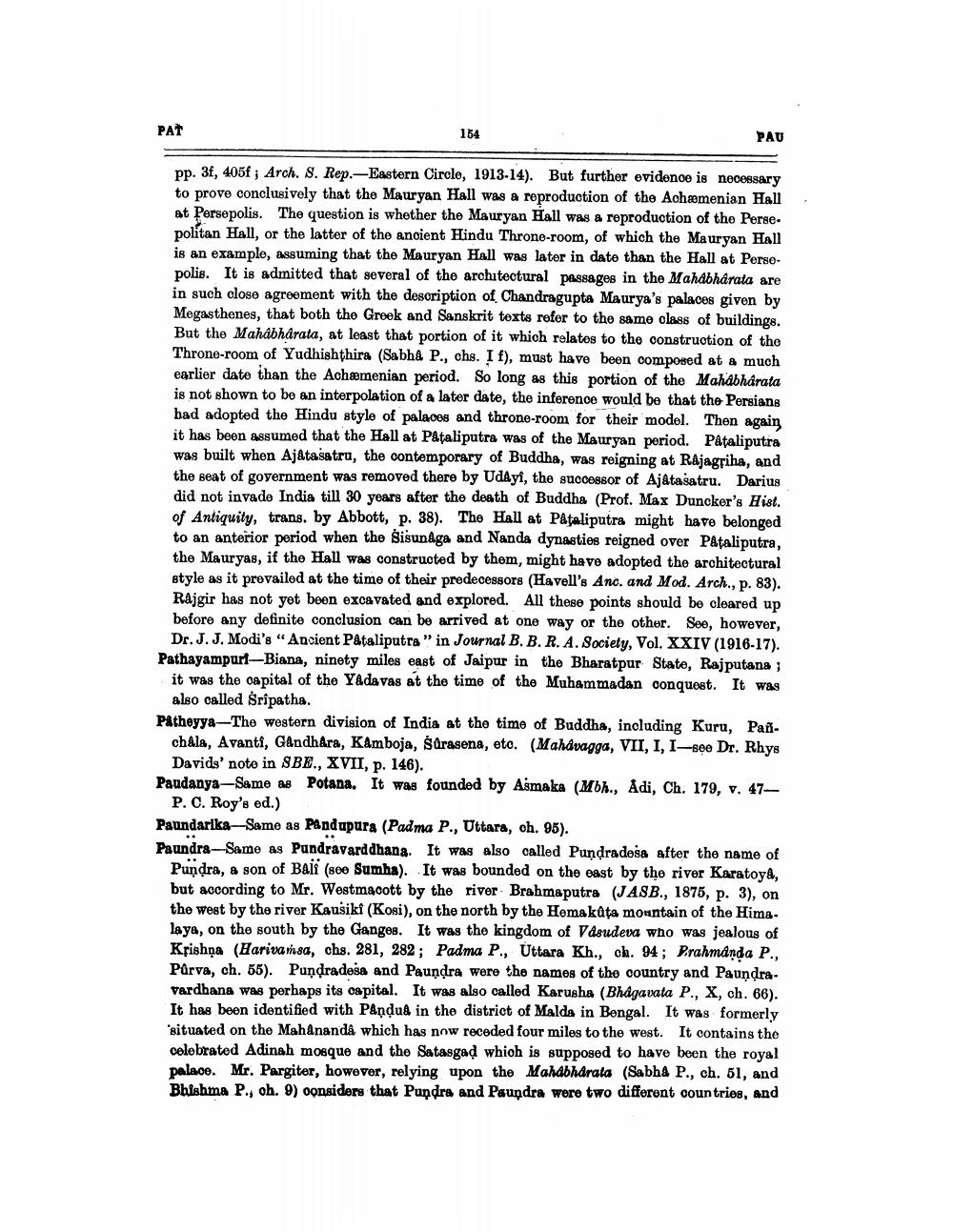________________
PAT
154
PAU
pp. 3f, 405f; Arch. S. Rep. Eastern Circle, 1913-14). But further evidence is necessary to prove conclusively that the Mauryan Hall was a reproduction of the Achæmenian Hall at Persepolis. The question is whether the Mauryan Hall was a reproduction of the Persepolitan Hall, or the latter of the ancient Hindu Throne-room, of which the Mauryan Hall is an example, assuming that the Mauryan Hall was later in date than the Hall at Persepolis. It is admitted that several of the architectural passages in the Mahabharata are in such close agreement with the description of Chandragupta Maurya's palaces given by Megasthenes, that both the Greek and Sanskrit texts refer to the same class of buildings. But the Mahabharata, at least that portion of it which relates to the construction of the Throne-room of Yudhishthira (Sabh& P., chs. I f), must have been composed at a much earlier date than the Achæmenian period. So long as this portion of the Mahabharata is not shown to be an interpolation of a later date, the inference would be that the Persians bad adopted the Hindu style of palaces and throne-room for their model. Then again it has been assumed that the Hall at Pataliputra was of the Mauryan period. Pataliputra was built when Ajatasatru, the contemporary of Buddha, was reigning at Rajagriha, and the seat of government was removed there by Udayi, the successor of Ajatasatru. Darius did not invade India till 30 years after the death of Buddha (Prof. Max Duncker's Hist. of Antiquity, trans, by Abbott, p. 38). The Hall at Pataliputra might have belonged to an anterior period when the Sisunaga and Nanda dynasties reigned over Pataliputra, the Mauryas, if the Hall was constructed by them, might have adopted the architectural style as it prevailed at the time of their predecessors (Havell's Anc. and Mod. Arch., p. 83). Rajgir has not yet been excavated and explored. All these points should be cleared up before any definite conclusion can be arrived at one way or the other. See, however,
Dr. J.J. Modi's "Ancient Pataliputra" in Journal B.B. R. A. Society, Vol. XXIV (1916-17). Pathayampurt-Biana, ninety miles east of Jaipur in the Bharatpur State, Rajputana ;
it was the capital of the Y&davas at the time of the Muhammadan conquest. It was
also called Sripatha. Patheyya-The western division of India at the time of Buddha, including Kuru, Pan
chAla, Avanti, GandhAra, Kamboja, Sarasena, eto. (Mahavagga, VII, I, 1-bee Dr. Rhys
Davids' note in SBE, XVII, p. 146). Paudanya-Same as Potana. It was founded by Asmaka (Mbh., Adi, Ch. 179, v. 47–
P. C. Roy's ed.) Paundarlka--Same as Pandapura (Padma P., Uttara, oh. 96). Paundra-Same as Pundravarddhana. It was also called Pundradesa after the name of
Pundra, a son of Bali (sce Sumha). It was bounded on the east by the river Karatoya, but according to Mr. Westmacott by the river - Brahmaputra (JASB., 1875, p. 3), on the west by the river Kausiki (Kosi), on the north by the Homa kata mountain of the Hima. laya, on the south by the Ganges. It was the kingdom of Vasudeva who was jealous of Krishna (Harivansa, chs. 281, 282; Padma P., Uttara Kh., ok. 94 ; Prahmanda P.. Pärva, ch. 55). Pundradesa and Paundra were the names of the country and PaundraVardhana was perhaps its capital. It was also called Karusha (Bhagavata P., X, oh. 66). It has been identified with Pandud in the district of Malda in Bengal. It was formerly 'situated on the MahAnandA which has now receded four miles to the west. It contains the celebrated Adinah mosque and the Satasgad which is supposed to have been the royal palace. Mr. Pargiter, however, relying upon the Mahabharata (Sabha P., ch. 51, and Bhishma P., oh. 9) considers that Pundra and Paundra were two different countries, and




